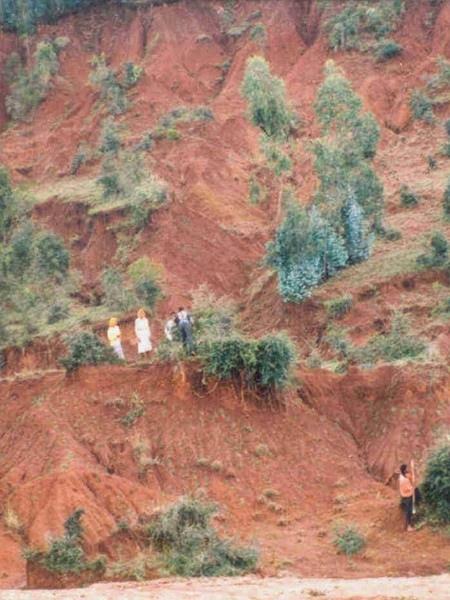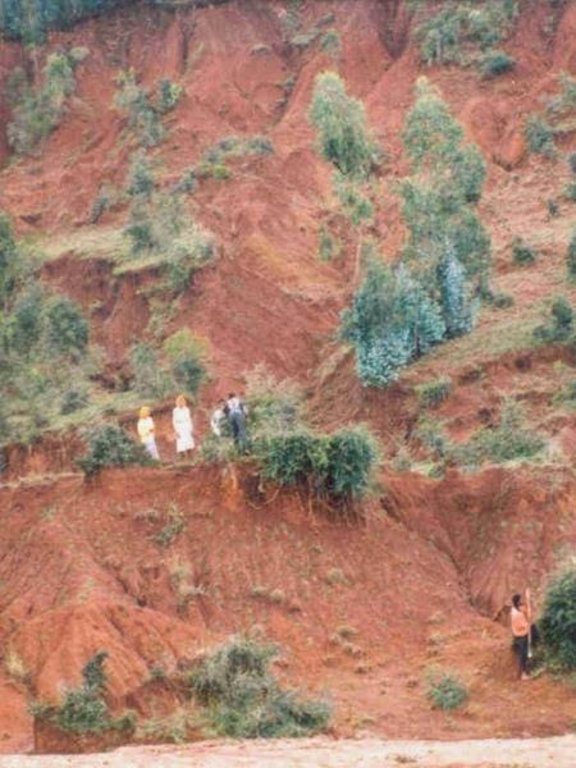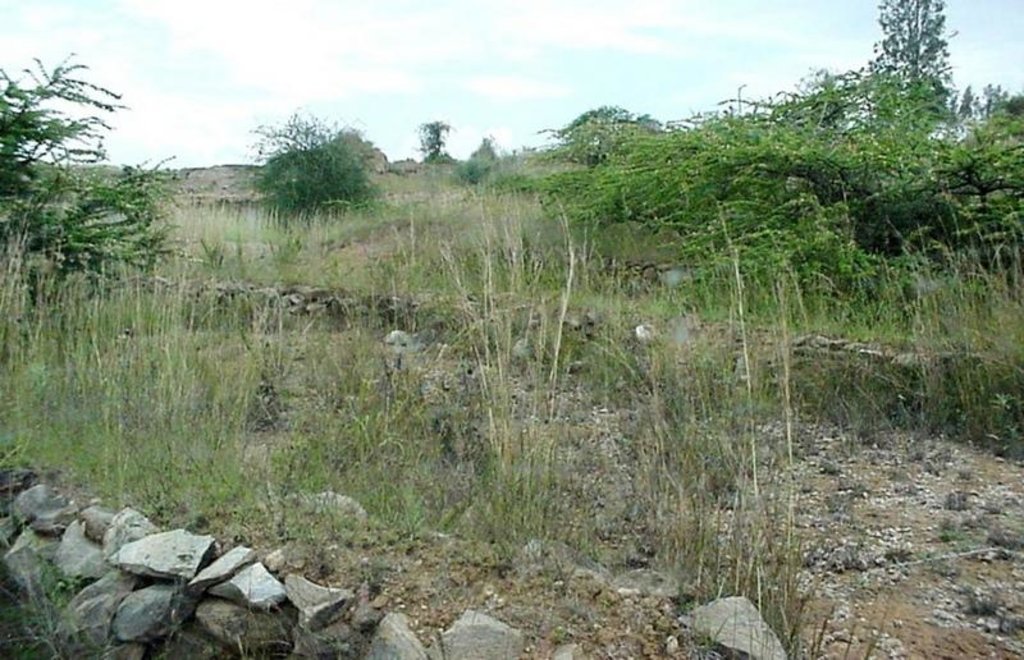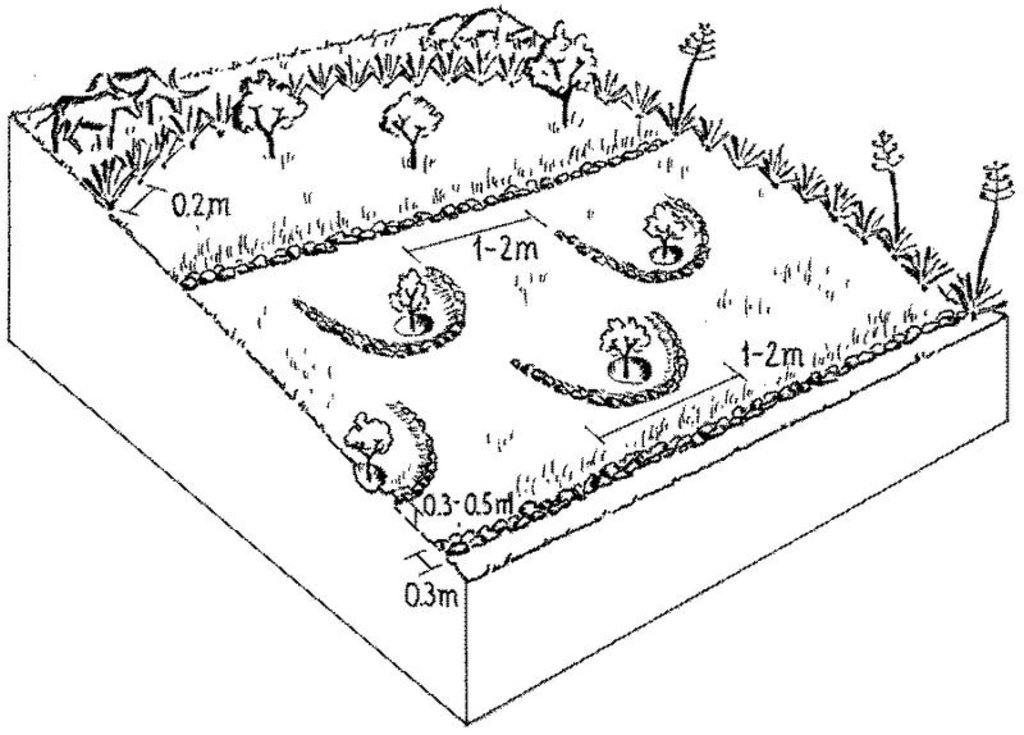Area closure for rehabilitation [Ethiopie]
- Création :
- Mise à jour :
- Compilateur : Daniel Danano
- Rédacteur : –
- Examinateur : Fabian Ottiger
Meret mekelel
technologies_1048 - Ethiopie
Voir les sections
Développer tout Réduire tout1. Informations générales
1.2 Coordonnées des personnes-ressources et des institutions impliquées dans l'évaluation et la documentation de la Technologie
Nom du projet qui a facilité la documentation/ l'évaluation de la Technologie (si pertinent)
Book project: where the land is greener - Case Studies and Analysis of Soil and Water Conservation Initiatives Worldwide (where the land is greener)Nom du ou des institutions qui ont facilité la documentation/ l'évaluation de la Technologie (si pertinent)
Ministry of Agriculture and Rural Development of Ethiopia (Ministry of Agriculture and Rural Development) - Ethiopie1.3 Conditions relatives à l'utilisation par WOCAT des données documentées
Quand les données ont-elles été compilées (sur le terrain)?
01/07/2003
Le compilateur et la(les) personne(s) ressource(s) acceptent les conditions relatives à l'utilisation par WOCAT des données documentées:
Oui
1.4 Déclaration sur la durabilité de la Technologie décrite
Est-ce que la Technologie décrite ici pose problème par rapport à la dégradation des terres, de telle sorte qu'elle ne peut pas être déclarée comme étant une technologie de gestion durable des terres?
Non
1.5 Référence au(x) questionnaire(s) sur les Approches de GDT
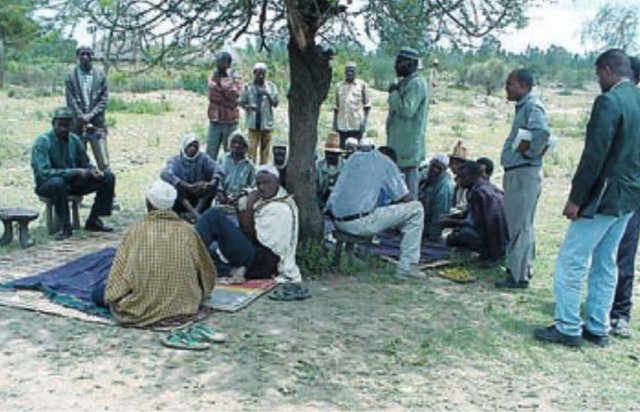
Local level participatory planning approach [Ethiopie]
An approach used by field staff to implement conservation activities, involving farmers in all stages of planning, implementation and evaluation.
- Compilateur : Daniel Danano
2. Description de la Technologie de GDT
2.1 Courte description de la Technologie
Définition de la Technologie:
Enclosing and protecting an area of degraded land from human use and animal interference, to permit natural rehabilitation, enhanced by additional vegetative and structural conservation measures.
2.2 Description détaillée de la Technologie
Description:
Area closure involves the protection and resting of severely degraded land to restore its productive capacity. There are two major types of area enclosures practised in Ethiopia: (1) the most common type involves closing of an area from livestock and people so that natural regeneration of the vegetation can take place; (2) the second option comprises closing off degraded land while simultaneously implementing additional measures such as planting of seedlings, mulching and establishing water harvesting structures to enhance and speed up the regeneration process. The focus of this case study is on this second type.
The selection of measures chosen for rehabilitation depends mainly on the land use type, and to a lesser extent on climate, topography and soil type. Degraded croplands with individual land use rights are normally treated with additional structural measures to retain soil moisture and trap sediment, and with agronomic measures to restore soil fertility. Open access grazing lands are closed for natural regeneration while partly treated with additional measures, and open access woodlands are simply closed. In the case study area 60% of the enclosed area is under treatment with additional conservation measures and 40% is under natural regeneration. First, the area to be closed is demarcated and protected with fencing, usually live fences, and a site guard may be assigned to further ensure protection. Structural measures such as micro-basins, trenches, and bunds that enhance water infiltration and soil moisture may be constructed to increase survival rate of vegetative material planted. Hillside terraces, spaced at a 1 m vertical interval with a width of 1 m are constructed on steep slopes (exceeding 20%). Nitrogen-fixing and multipurpose shrubs/trees (for fodder, fuel) such as Acacia saligna, Sesbania sesban, Leucaena leucocephala as well as local grass species such as napier (Pennisetum purpureum) and rhodes (Chloris gayana) are planted as additional measures for conservation.
The maintenance of area enclosures involves activities such as replanting, maintaining of fences, pruning of trees and weeding. After one year, cut-and-carry of grass for stall-feeding can be partly practiced - which is of economic benefit to the farmers. Rehabilitation normally takes about 7-10 years depending on the level of degradation and intensity of management. Land use is limited to selective cutting of trees, collection of dead wood and cut-and-carry of grass for livestock fodder. On individually owned enclosures land users start cutting trees after three years (for eucalyptus) and after 7–8 years (for other trees), while on communal land farmers are allowed to collect dead wood after 3-–4 years, and the community decides about the use of trees.
2.3 Photos de la Technologie
2.5 Pays/ région/ lieux où la Technologie a été appliquée et qui sont couverts par cette évaluation
Pays:
Ethiopie
Région/ Etat/ Province:
Alaba, South Ethiopia
Autres spécifications du lieu:
Bilate River Catchment (Rift Valley)
Map
×2.7 Introduction de la Technologie
Spécifiez comment la Technologie a été introduite: :
- par le biais de projets/ d'interventions extérieures
3. Classification de la Technologie de GDT
3.1 Principal(aux) objectif(s) de la Technologie
- améliorer la production
- réduire, prévenir, restaurer les terres dégradées
- préserver l'écosystème
3.2 Type(s) actuel(s) d'utilisation des terres, là où la Technologie est appliquée

Mixte (cultures/ pâturages/ arbres), incluant l'agroforesterie
- Sylvo-pastoralisme
Commentaires:
Major land use problems (compiler’s opinion): Over 30% of the land in the study area is degraded, resulting in low crop yields and poor livestock production. Severe water erosion is the main cause of land degradation on all slopes, followed by fertility depletion due to intensive cultivation practices and overgrazing. Serious gully formation and a high sediment load in the Bilate River threaten Lake Abaya. Communal grazing lands, woodlands with open access, and cultivated lands on steep slopes without conservation measures are particularly affected. By tradition, land users in rural Ethiopia can own as many livestock as they wish, which encourages overstocking.
Ranching: (before SWC)
Other grazingland: mixed silvo-pastoral (after SWC): cut-and-carry, trees
3.3 Informations complémentaires sur l'utilisation des terres
Approvisionnement en eau des terres sur lesquelles est appliquée la Technologie:
- pluvial
Précisez:
Longest growing period in days: 120 Longest growing period from month to month: Jun - Sep
3.4 Groupe de GDT auquel appartient la Technologie
- fermeture de zones (arrêt de tout usage, appui à la réhabilitation)
- mesures en travers de la pente
3.5 Diffusion de la Technologie
Commentaires:
Total area covered by the SLM Technology is 20 m2.
3.6 Mesures de GDT constituant la Technologie
3.7 Principaux types de dégradation des terres traités par la Technologie

érosion hydrique des sols
- Wt: perte de la couche superficielle des sols (couche arable)/ érosion de surface
- Wg: ravinement/ érosion en ravines
- Wo: effets hors-site de la dégradation

dégradation chimique des sols
- Cn: baisse de la fertilité des sols et réduction du niveau de matière organique (non causée par l’érosion)

dégradation biologique
- Bc: réduction de la couverture végétale
- Bs: baisse de la qualité et de la composition/ diversité des espèces
Commentaires:
Main type of degradation addressed: Wt: loss of topsoil / surface erosion, Wg: gully erosion / gullying, Wo: offsite degradation effects, Cn: fertility decline and reduced organic matter content, Bc: reduction of vegetation cover, Bs: quality and species composition /diversity decline
3.8 Prévention, réduction de la dégradation ou réhabilitation des terres dégradées
Spécifiez l'objectif de la Technologie au regard de la dégradation des terres:
- restaurer/ réhabiliter des terres sévèrement dégradées
4. Spécifications techniques, activités, intrants et coûts de mise en œuvre
4.1 Dessin technique de la Technologie
4.2 Spécification/ explications techniques du dessin technique
Rehabilitation of degraded land based on enclosure with live fence. Natural regeneration of vegetative cover is supported by water harvesting structures and planting of nitrogen-fixing/multipurpose shrubs and trees as well as local grass species. On steeper slopes hillside terraces may be established.
Technical knowledge required for field staff / advisors: moderate
Technical knowledge required for land users: moderate
Main technical functions: improvement of ground cover, increase of infiltration, control of dispersed runoff, control of concentrated runoff, increase in soil fertility
Secondary technical functions: increase / maintain water stored in soil, less sediment deportation
Mulching
Material/ species: tree leaves/grass
Scattered / dispersed
Vegetative material: T : trees / shrubs
Vegetative measure: oversowing grasses
Vegetative material: G : grass
Vegetative measure: Vegetative material: G : grass
Vegetative measure: Vegetative material: G : grass
Vegetative measure: Vegetative material: G : grass
Trees/ shrubs species: Acacia saligna, Sesbania sesban, Leucaena leucocephala, Eucalyptus spp., Grevillea robusta
Grass species: nepier (Pennisetum purpureum), rhodes (Chloris gayana)
Structural measure: micro-basins (opt.)
Structural measure: terraces (opt.)
Structural measure: bunds (opt.)
Other type of management: land use change, enclosure,, cut-and-carry
4.4 Activités de mise en place/ d'établissement
| Activité | Type de mesures | Calendrier | |
|---|---|---|---|
| 1. | Planting of trees (Eucalyptus spp., Grevillea robusta) as well as | Végétale | (early rainy season). |
| 2. | Oversowing/interplanting with local grass species: napier grass | Végétale | (early rainy season). |
| 3. | Marking the boundary and establishment of live fences: digging pits | Structurel | early rainy season (before June). |
| 4. | Construction of structural measures such as micro- basins, trenches, bunds or hillside terraces. | Structurel | before rains |
4.5 Coûts et intrants nécessaires à la mise en place
| Spécifiez les intrants | Unité | Quantité | Coûts par unité | Coût total par intrant | % des coût supporté par les exploitants des terres | |
|---|---|---|---|---|---|---|
| Main d'œuvre | Labour | ha | 1,0 | 175,0 | 175,0 | 50,0 |
| Equipements | Tools | ha | 1,0 | 25,0 | 25,0 | 100,0 |
| Matériel végétal | Seeds | ha | 1,0 | 40,0 | 40,0 | |
| Matériel végétal | Seedlings | ha | 1,0 | 150,0 | 150,0 | |
| Matériaux de construction | Stone | ha | 1,0 | |||
| Matériaux de construction | Wood | ha | 1,0 | |||
| Autre | site guard (kg grain/ha/year) | ha | 1,0 | 1,0 | 1,0 | 100,0 |
| Coût total de mise en place de la Technologie | 391,0 | |||||
Commentaires:
Duration of establishment phase: 2 month(s)
4.6 Activités d'entretien/ récurrentes
| Activité | Type de mesures | Calendrier/ fréquence | |
|---|---|---|---|
| 1. | Mulching with tree leaves/grass around newly planted trees, before | Agronomique | before rains / initial establishment |
| 2. | Replanting/gapping up live fence and trees during rains in the early | Végétale | during rains / |
| 3. | Harvesting grass | Végétale | during rainy season. / |
| 4. | Pruning of trees | Végétale | in the dry season. / |
| 5. | Weeding | Végétale | after rains. / |
| 6. | Repairing breaks in structures | Structurel | before rains./ |
4.7 Coûts et intrants nécessaires aux activités d'entretien/ récurrentes (par an)
| Spécifiez les intrants | Unité | Quantité | Coûts par unité | Coût total par intrant | % des coût supporté par les exploitants des terres | |
|---|---|---|---|---|---|---|
| Main d'œuvre | Labour | ha | 1,0 | 35,0 | 35,0 | 100,0 |
| Equipements | Tools | ha | 1,0 | 5,0 | 5,0 | 100,0 |
| Matériel végétal | Seeds | ha | 1,0 | 10,0 | 10,0 | |
| Matériel végétal | Seedlings | ha | 1,0 | 40,0 | 40,0 | |
| Autre | site guard (kg grain/ha/year) | ha | 1,0 | 1,0 | 1,0 | 100,0 |
| Coût total d'entretien de la Technologie | 91,0 | |||||
Commentaires:
Labour for establishment activities: 250 person days per ha for structural measures and planting of trees, plus guarding. Labour for maintenance: 50 person days for replanting/weeding. A common daily wage is US$ 0.70 (= 6 Ethiopian Birr), however in this case the site guards were given 3 kg of grains per ha per year. They can control over 200 ha.
5. Environnement naturel et humain
5.1 Climat
Précipitations annuelles
- < 250 mm
- 251-500 mm
- 501-750 mm
- 751-1000 mm
- 1001-1500 mm
- 1501-2000 mm
- 2001-3000 mm
- 3001-4000 mm
- > 4000 mm
Spécifications/ commentaires sur les précipitations:
751-1,000 mm (ranked 1)
1,001-1,500 mm (ranked 2)
Zone agro-climatique
- subhumide
- semi-aride
Thermal climate class: tropics
5.2 Topographie
Pentes moyennes:
- plat (0-2 %)
- faible (3-5%)
- modéré (6-10%)
- onduleux (11-15%)
- vallonné (16-30%)
- raide (31-60%)
- très raide (>60%)
Reliefs:
- plateaux/ plaines
- crêtes
- flancs/ pentes de montagne
- flancs/ pentes de colline
- piémonts/ glacis (bas de pente)
- fonds de vallée/bas-fonds
Zones altitudinales:
- 0-100 m
- 101-500 m
- 501-1000 m
- 1001-1500 m
- 1501-2000 m
- 2001-2500 m
- 2501-3000 m
- 3001-4000 m
- > 4000 m
Commentaires et précisions supplémentaires sur la topographie:
Altitudinal zone: Also 1,001-1,500 m a.s.l. (ranked 2) and 2001-2500 m a.s.l. (ranked 3)
Slopes on average: Also hilly (ranked 2) and moderate (ranked 3)
5.3 Sols
Profondeur moyenne du sol:
- très superficiel (0-20 cm)
- superficiel (21-50 cm)
- modérément profond (51-80 cm)
- profond (81-120 cm)
- très profond (>120 cm)
Texture du sol (de la couche arable):
- grossier/ léger (sablonneux)
- moyen (limoneux)
Matière organique de la couche arable:
- faible (<1%)
Si disponible, joignez une description complète du sol ou précisez les informations disponibles, par ex., type de sol, pH/ acidité du sol, capacité d'échange cationique, azote, salinité, etc.
Soil depth on average: Also moderately deep (ranked 2) and deep (ranked 3)
Soil fertility: Low
Topsoil organic matter: Also medium and high (both ranked 2)
Soil drainage/infiltration: Good
Soil water storage capacity: Very high
5.6 Caractéristiques des exploitants des terres appliquant la Technologie
Orientation du système de production:
- subsistance (auto-approvisionnement)
Revenus hors exploitation:
- moins de 10% de tous les revenus
Indiquez toute autre caractéristique pertinente des exploitants des terres:
Off-farm income specification: from petty trade, weaving, etc
5.7 Superficie moyenne des terres détenues ou louées par les exploitants appliquant la Technologie
- < 0,5 ha
- 0,5-1 ha
- 1-2 ha
- 2-5 ha
- 5-15 ha
- 15-50 ha
- 50-100 ha
- 100-500 ha
- 500-1 000 ha
- 1 000-10 000 ha
- > 10 000 ha
5.8 Propriété foncière, droits d’utilisation des terres et de l'eau
Propriété foncière:
- état
Droits d’utilisation des terres:
- accès libre (non organisé)
- individuel
6. Impacts et conclusions
6.1 Impacts sur site que la Technologie a montrés
Impacts socio-économiques
Production
production fourragère
Commentaires/ spécifiez:
(cut-and-carry of grass)
qualité des fourrages
Commentaires/ spécifiez:
(cut-and-carry of grass)
production de bois
surface de production
Commentaires/ spécifiez:
Reduction of grazing area leads to high pressure on remaining grazing areas
Revenus et coûts
dépenses pour les intrants agricoles
revenus agricoles
Commentaires/ spécifiez:
(selling grass/wood)
charge de travail
Impacts socioculturels
institutions communautaires
connaissances sur la GDT/ dégradation des terres
apaisement des conflits
Commentaires/ spécifiez:
Unequal share of benefits, some illegal cutting of vegetation is involved
Impacts écologiques
Cycle de l'eau/ ruissellement
drainage de l'excès d'eau
Sols
humidité du sol
Commentaires/ spécifiez:
>50%
couverture du sol
Commentaires/ spécifiez:
>80%
perte en sol
Commentaires/ spécifiez:
initially 50% reduction, after 2–3 years
Autres impacts écologiques
Soil fertility
Commentaires/ spécifiez:
increased organic matter, nitrogen fixing shrubs
Biodiversity
Commentaires/ spécifiez:
recovering disappearing local species
competition between (grass)species
Commentaires/ spécifiez:
competition between naturally regenerating and oversown (grass)species
6.2 Impacts hors site que la Technologie a montrés
flux des cours d'eau fiables et stables en saison sèche
Commentaires/ spécifiez:
Also groundwater recharge
inondations en aval
envasement en aval
Commentaires/ spécifiez:
Less sediment transported
pollution des rivières/ nappes phréatiques
6.4 Analyse coûts-bénéfices
Quels sont les bénéfices comparativement aux coûts de mise en place (du point de vue des exploitants des terres)?
Rentabilité à court terme:
positive
Rentabilité à long terme:
très positive
Quels sont les bénéfices comparativement aux coûts d'entretien récurrents (du point de vue des exploitants des terres)?
Rentabilité à court terme:
positive
Rentabilité à long terme:
très positive
6.5 Adoption de la Technologie
Parmi tous ceux qui ont adopté la Technologie, combien d'entre eux l'ont fait spontanément, à savoir sans recevoir aucune incitation matérielle ou aucun paiement?
- 90-100%
Commentaires:
300 land user families have adopted the Technology with external material support
90% of land user families have adopted the Technology without any external material support
There is a moderate trend towards spontaneous adoption of the Technology
Comments on adoption trend: Adoption rate has considerably increased owing to improved ownership feeling and immense benefits obtained through the practice. However, if labour-intensive structural measures are required people rely on food-for-work incentives.
6.7 Points forts/ avantages/ possibilités de la Technologie
| Points forts/ avantages/ possibilités du point de vue du compilateur ou d'une autre personne ressource clé |
|---|
|
Reduction of on-site and off-site land degradation, reclamation of degraded non-productive land (regenerating fertility) How can they be sustained / enhanced? Strengthen maintenance and protection to increase biomass production of enclosure. |
|
Fodder shortage is reduced through cut-and-carry of grass in enclosures (after 1 year) How can they be sustained / enhanced? Introduce more productive and nutritious grass/legume species. |
|
Collection of dead wood from enclosures (after 3–4 years) mitigates fuelwood shortage How can they be sustained / enhanced? Introduce alternative fast growing multi-purpose tree species such as Grevillea robusta (fodder for smallstock in very dry periods). |
|
Cutting wood for construction of houses and wooden farm implements (after 7–8 years) How can they be sustained / enhanced? Continue planting of multipurpose trees. |
|
Increased honey production through increased bee activity in enclosures Emerge of springs, which have disappeared due to deforestation/land degradation Income generation: farmers sell grass/wood collected from area enclosures; they make profit despite seven years enclosure How can they be sustained / enhanced? Improve beehives, ‘bee feed’ (bee-friendly plants), and access to market. Maintain proper ground cover to improve infiltration and percolation of rainwater. Better management of planted grass, making of hay, improve market systems. |
|
Emergence of springs, which have disappeared due to deforestation/land degradation -> Maintain proper ground cover to improve infiltration and percolation of rainwater. - Income generation: farmers sell grass/wood collected from area enclosures; they make profit despite seven years enclosure -> Better management of planted grass, making of hay, improve market systems. Editors’ comments: Protecting degraded land against grazing is a common practice worldwide. In Ethiopia it is the second most important SWC practice after structural conservation measures. About 1.2 million hectares of degraded lands have been closed for rehabilitation in Ethiopia during the past three decades. As this case study shows, results are encouraging both in terms of effective protection and enhanced production. Land use rights: open access on woodlands and grazing lands (communal land use rights), individual on cropland |
6.8 Faiblesses/ inconvénients/ risques de la Technologie et moyens de les surmonter
| Faiblesses/ inconvénients/ risques du point de vue du compilateur ou d'une autre personne ressource clé | Comment peuvent-ils être surmontés? |
|---|---|
| On highly eroded areas and in areas with low rainfall the survival rate of trees and shrubs is low and as a result the benefits only come after a very long period. This situation becomes unacceptable to the land users |
Select suitable local and exotic multipurpose tree/shrub species adapted to the local conditions (Acacia spp., Eucalyptus spp., Grevillea robusta etc). Construct water-harvesting structures (trenches, micro-basins). Raise awareness among land users through meetings and training. |
| Investment costs are rather high for land users | Credits, loans, cooperatives. |
| Inequitable share of benefits | Awareness should be increased through enhancing the LLPP approach. |
7. Références et liens
7.2 Références des publications disponibles
Titre, auteur, année, ISBN:
Chadokar PA: Multipurpose Plant Species for Soil and Water Conservation. Assistance to Soil and Water ConservationProgramme. ETH/81/003. 1985.
Titre, auteur, année, ISBN:
Betru Nedassa: Biological Soil Conservation Measures. Land Rehabilitation and Reforestation Project. Project 2488MOA/WFP. 1995.
Liens et modules
Développer tout Réduire toutLiens

Local level participatory planning approach [Ethiopie]
An approach used by field staff to implement conservation activities, involving farmers in all stages of planning, implementation and evaluation.
- Compilateur : Daniel Danano
Modules
Aucun module trouvé


